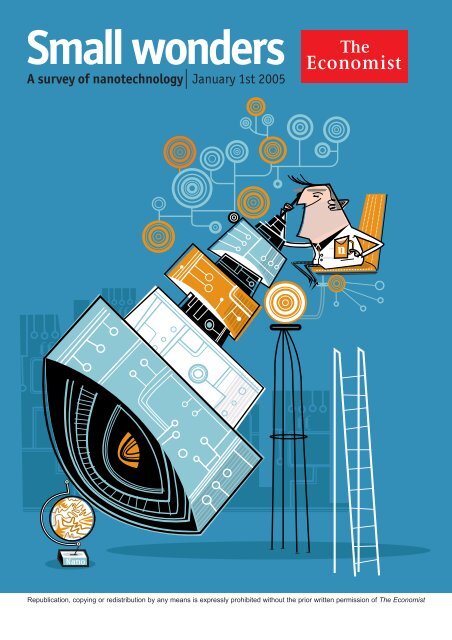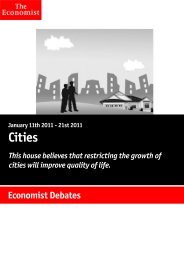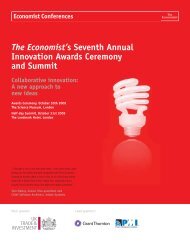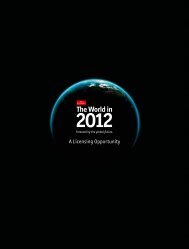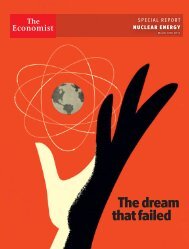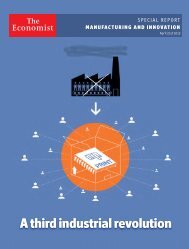Small wonders
Small wonders
Small wonders
Create successful ePaper yourself
Turn your PDF publications into a flip-book with our unique Google optimized e-Paper software.
<strong>Small</strong> <strong>wonders</strong><br />
A survey of nanotechnology January 1st 2005<br />
Republication, copying or redistribution by any means is expressly prohibited without the prior written permission of The Economist
The Economist January 1st 2005 A survey of nanotechnology 1<br />
Also in this section<br />
Apply here<br />
Where very small things can make a big<br />
dierence. Page 3<br />
Fear and loathing<br />
Some of the worries about nanotechnology<br />
are rational, some not. Page 5<br />
Downsizing<br />
Companies both large and small hope to make<br />
big money from tiny particles. Page 7<br />
Handle with care<br />
Nanotechnology promises great benets, but<br />
safeguards will be essential. Page 9<br />
Acknowledgments<br />
The author is grateful to many individuals and<br />
organisations for their help in the preparation of this<br />
survey. Particular thanks go to Gerd Binnig, Richard<br />
<strong>Small</strong>ey, Mark Welland, Michael Lesnick, Scott Walsh,<br />
Margaret Blohm, Eric Drexler, Bruce Hopkins and François<br />
Grey. Reports from Lux Research and CMP Cientica proved<br />
especially useful.<br />
A list of sources can be found online<br />
www.economist.com/surveys<br />
An audio interview with the author is at<br />
www.economist.com/audio<br />
<strong>Small</strong> <strong>wonders</strong><br />
Nanotechnology will give humans greater control of matter at tiny<br />
scales. That is a good thing, says Natasha Loder<br />
ATOMS are the fundamental building<br />
blocks of matter, which means they<br />
are very small indeed. The world at the<br />
scale of atoms and molecules is dicult to<br />
describe and hard to imagine. It is so odd<br />
that it even has its own special branch of<br />
physics, called quantum mechanics, to explain<br />
the strange things that happen there.<br />
If you were to throw a tennis ball against a<br />
brick wall, you might be surprised if the<br />
ball passed cleanly through the wall and<br />
sailed out on the other side. Yet this is the<br />
kind of thing that happens at the quantum<br />
scale. At very small scales, the properties<br />
of a material, such as colour, magnetism<br />
and the ability to conduct electricity, also<br />
change in unexpected ways.<br />
It is not possible to see the atomic<br />
world in the normal sense of the word, because<br />
its features are smaller than the<br />
wavelength of visible light (see table 1,<br />
next page). But back in 1981, researchers at<br />
IBM designed a probe called the scanning<br />
tunnelling microscope (STM), named after<br />
a quantum-mechanical eect it employs.<br />
Rather like the stylus on an old-fashioned<br />
record player, it could trace the bumps and<br />
grooves of the nanoscale world. This allowed<br />
scientists to see atoms and molecules<br />
for the rst time. It revealed landscapes<br />
as beautiful and complex as the<br />
ridges, troughs and valleys of a Peruvian<br />
mountainside, but at the almost unimaginably<br />
small nanometre (nm) scale.<br />
A nanometre is a billionth of a metre, or<br />
roughly the length of ten hydrogen atoms.<br />
Although scientists had thought about tin-<br />
kering with things this small as long ago as<br />
the late 1950s, they had to wait until the invention<br />
of the STM to make it possible.<br />
Nanotechnology is generally agreed to<br />
cover objects measuring from 1 to 100nm,<br />
though the denition is somewhat arbitrary.<br />
Some people include things as small<br />
as a tenth of a nanometre, which is about<br />
the size of the bond between two carbon<br />
atoms. At the other end of the range, in objects<br />
larger than 50nm the laws of classical<br />
physics become increasingly dominant.<br />
There are plenty of materials that simply<br />
happen to have features at the nanoscalesuch<br />
as stained glass, mayonnaise<br />
or cat litterbut do not qualify for the nanotechnology<br />
label. The point about nanotechnology<br />
is that it sets out deliberately<br />
to exploit the strange properties<br />
found in these very small worlds.<br />
At the nanoscale, explains George<br />
Smith, the amiable head of materials science<br />
at Oxford University, new, exciting<br />
and dierent properties can be found. If<br />
you were to start with a grain of sugar, he<br />
says, and chopped it up into ever smaller<br />
pieces and simply ended up with a tiny<br />
grain of sugar, that would be no big deal.<br />
But as an object gets smaller, the ratio between<br />
its surface area and its volume rises.<br />
This matters because the atoms on the surface<br />
of a material are generally more reactive<br />
than those at its centre.<br />
So icing sugar, for instance, dissolves<br />
more quickly in water than does the granulated<br />
form. And if silver is turned into very<br />
small particles, it has antimicrobial prop-1
2 A survey of nanotechnology The Economist January 1st 2005<br />
From ants to atoms<br />
One millimetre = 1m nanometres (nm)<br />
Item Size in nm<br />
Red ant 5m<br />
Human hair (width) 80,000<br />
Diameter of a typical bacterium 1,000-10,000<br />
Average wavelength of visible light 400-700<br />
Human immunodeficiency virus 90<br />
Wavelength of extreme ultraviolet light 40<br />
Cell membrane 10<br />
Diameter of DNA ~ 2.5<br />
Ten hydrogen atoms 1<br />
Water molecule (width) 0.3<br />
Sources: Wikipedia; National Institute of Standards and<br />
Technology; Intel; Royal Society; R. <strong>Small</strong>ey<br />
2<br />
erties that are not present in the bulk material.<br />
One company exploits this phenomenon<br />
by making nanoparticles of the<br />
compound cerium oxide, which in that<br />
form are chemically reactive enough to<br />
serve as a catalyst.<br />
In this invisible world, tiny particles of<br />
gold melt at temperatures several hundred<br />
degrees lower than a large nugget, and copper,<br />
which is normally a good conductor<br />
of electricity, can become resistant in thin<br />
layers in the presence of a magnetic eld.<br />
Electrons, like that imaginary tennis ball,<br />
can simply jump (or tunnel) from one<br />
place to another, and molecules can attract<br />
each other at moderate distances. This effect<br />
allows geckos to walk on the ceiling,<br />
using tiny hairs on the soles of their feet.<br />
But nding novel properties at the<br />
nanoscale is only the rst step. The next is<br />
to make use of this knowledge. Most usefully,<br />
the ability to make stu with atomic<br />
precision will allow scientists to produce<br />
materials with improved, or new, optical,<br />
magnetic, thermal or electrical properties.<br />
And even just understanding the atomicscale<br />
defects in a material can suggest better<br />
ways of making it.<br />
Indeed, entirely new kinds of material<br />
are now being developed. For example,<br />
NanoSonic in Blacksburg, Virginia, has<br />
created metallic rubber, which exes and<br />
stretches like rubber but conducts electricity<br />
like a solid metal. General Electric’s research<br />
centre in Schenectady in New York<br />
state is trying to make exible ceramics. If<br />
it succeeds, the material could be used for<br />
jet-engine parts, allowing them to run at<br />
higher, more ecient temperatures. And<br />
several companies are working on materials<br />
that could one day be made into solar<br />
cells in the form of paint.<br />
Because nanotechnology has such<br />
1<br />
broad applications, many people think<br />
that it may turn out to be as important as<br />
electricity or plastic. As this survey will<br />
show, nanotechnology will indeed aect<br />
every industry through improvements to<br />
existing materials and products, as well as<br />
allowing the creation of entirely new materials.<br />
Moreover, work at the smallest of<br />
scales will produce important advances in<br />
areas such as electronics, energy and biomedicine.<br />
From small beginnings<br />
Nanotechnology does not derive from a<br />
single scientic discipline. Although it<br />
probably has most in common with materials<br />
science, the properties of atoms and<br />
molecules underpin many areas of science,<br />
so the eld attracts scientists of dierent<br />
disciplines. Worldwide, around<br />
20,000 people are estimated to be working<br />
in nanotechnology, but the sector is hard<br />
to dene. <strong>Small</strong>-scale work in electronics,<br />
optics and biotechnology may have been<br />
relabelled nanobiotechnology, nanooptics<br />
and nanoelectronics because<br />
nano-anything has become fashionable.<br />
The nano prex is thought to derive<br />
from the Greek noun for dwarf. Oxford’s<br />
Mr Smith jokingly oers an alternative explanation:<br />
that it comes from the verb<br />
which means to seek research funding.<br />
And research funding is certainly available<br />
by the bucketload. Lux Research, a nanotechnology<br />
consultancy based in New<br />
York, estimates that total spending on nanotechnology<br />
research and development<br />
by governments, companies and venture<br />
capitalists worldwide was more than $8.6<br />
billion in 2004, with over half coming<br />
from governments. But Lux predicts that in<br />
future years companies are likely to spend<br />
more than governments.<br />
For America, nanotechnology is the<br />
largest federally funded science initiative<br />
Growing up<br />
Government nanotechnology spending, $bn<br />
Other<br />
United States<br />
Japan<br />
Western Europe<br />
0<br />
1997 98 99 2000 01 02 03 04*<br />
Source: Lux Research<br />
*Estimate<br />
5<br />
4<br />
3<br />
2<br />
1<br />
2<br />
since the country decided to put a man on<br />
the moon. In 2004, the American government<br />
spent $1.6 billion on it, well over<br />
twice as much as it did on the Human Genome<br />
Project at its peak. In 2005, it is planning<br />
to shell out a further $982m. Japan is<br />
the next biggest spender, and other parts<br />
of Asia as well as Europe have also joined<br />
the funding race (see chart 2). Perhaps surprisingly,<br />
the contenders include many developing<br />
countries, such as India, China,<br />
South Africa and Brazil.<br />
In the six years up to 2003, nanotechnology<br />
investment reported by government<br />
organisations increased roughly<br />
sevenfold, according to gures from Mihail<br />
Roco, senior adviser for nanotechnology<br />
at America’s National Science Foundation.<br />
This large amount of funding has raised<br />
expectations that may not be met. Some<br />
people worry that all the nanotechnology<br />
start-ups will help to inate a bubble reminiscent<br />
of the internet one. But there are<br />
good reasons to think that the risk has<br />
been exaggerated. Private investors are being<br />
much more cautious than they were<br />
during the dotcom boom, and much of the<br />
money that is being spent by governments<br />
is going on basic science and on developing<br />
technologies that will not become<br />
available for years.<br />
However, a number of existing products<br />
have already been improved<br />
through nanotechnology, with more to<br />
come in the next few years. Bandages for<br />
burns have been made antimicrobial by<br />
the addition of nanoparticles of silver.<br />
Fabrics have been stain- and odourproofed<br />
by attaching molecules to cotton<br />
bres that create a protective barrier. Tennis<br />
rackets have been strengthened by adding<br />
tiny particles that improve torsion and<br />
ex resistance. Other applications include<br />
coatings for the hulls of boats, sunscreen,<br />
car parts and refrigerators. In the longer<br />
term nanotechnology may produce much<br />
bigger innovations, such as new kinds of<br />
computer memory, improved medical<br />
technology and better energy-production<br />
methods such as solar cells.<br />
The technology’s most ardent proponents<br />
claim that it will lead to clean energy,<br />
zero-waste manufacturing and cheap<br />
space travel, if not immortality. Its opponents<br />
fear that it will bring universal surveillance<br />
and harm the poor, the environment<br />
and human healthand may even<br />
destroy the whole planet through self-replicating<br />
grey goo. This survey will argue<br />
that both sides overstate their case, but<br />
that on balance nanotechnology should<br />
be welcomed. 7
The Economist January 1st 2005 A survey of nanotechnology 3<br />
Apply here<br />
Where very small things can make a big dierence<br />
RGON! Up, up! Come on, boy, let’s<br />
Ago! Don Eigler, a researcher at<br />
IBM’s Almaden Research Centre in California,<br />
is one of the world’s experts in moving<br />
atoms. In 1989, he spelled out the letters<br />
IBM in xenon atoms, which made him<br />
the rst person to move atoms individually.<br />
But today he is having trouble persuading<br />
his large Leonberger dog to get up<br />
from the oce oor.<br />
If dogs were as easy to move as atoms,<br />
Mr Eigler would be able to get Argon out of<br />
the oce by using a computer mouse to<br />
point, click and drag him. But although the<br />
ability to move individual atoms is impressive,<br />
it is not particularly useful for<br />
anyone but experimental scientists like Mr<br />
Eigler. Most researchers think that moving<br />
atoms one by one will not be a practical<br />
way of creating new materials.<br />
A better way may be to exploit the natural<br />
tendencies of atoms and molecules to<br />
crystallise, fold, form layers or otherwise<br />
self-assemble. Ordered molecular structures<br />
arise spontaneously, for example in<br />
crystallisation or in the formation of a<br />
snowake. Scientists have already learnt<br />
how to use self-assembly to build nanoscale<br />
clusters of atoms, layers, pillars,<br />
tubes, ribbons, spheres, rods and rings, as<br />
well as more complex assemblies that resemble<br />
natural structures such as helices<br />
or even owers. Much current research is<br />
concentrated on nding ways of arranging<br />
such nanoscale structures so they could<br />
serve as devices for, say, storing information<br />
or generating electricity from light to<br />
make solar cells.<br />
Some, such as Harry Kroto, an eminent<br />
professor of chemistry at Britain’s University<br />
of Sussex, say that nanotechnology is<br />
no more than advanced chemistry. But although<br />
so far much of nanotechnology<br />
has resembled traditional chemistry,<br />
increasingly the driving forces behind it<br />
are physics, engineering, materials science<br />
and information technology. These disciplines<br />
have brought new tools for working<br />
at the nanoscale, and for building in it too.<br />
They include the modern descendants of<br />
the scanning tunnelling microscope, and<br />
tools for writing, printing and even picking<br />
things up. Existing tools have also become<br />
more useful, having been combined with<br />
powerful computing, automation and visualisation<br />
methods such as virtual reality.<br />
All this work is allowing researchers to<br />
build libraries of new materials with different<br />
and useful properties, along with instructions<br />
on how to build them.<br />
First catch your tube<br />
In 1991, a researcher working at the NEC<br />
Corporation in Tsukuba, Japan, discovered<br />
a new form of carbon that turned out to<br />
have extraordinary properties. The socalled<br />
carbon nanotube is like a tiny sheet<br />
of graphite rolled into a cylinder, with a<br />
diameter of around a nanometre, and is<br />
very strong and light. It has become the<br />
star of nanotechnology. A host of uses has<br />
been proposed for it, including in sensors,<br />
molecular probes, computer memory,<br />
televisions, batteries and fuel cells. The list<br />
lengthens every time a new property is<br />
discovered in a slightly dierently shaped<br />
or sized tube. In 2003 scientists at the University<br />
of Texas at Dallas found a way of<br />
spinning nanotubes into bres to make the<br />
world’s toughest polymer.<br />
Meyya Meyyappan, head of nanotechnology<br />
at NASA, America’s space agency,<br />
says that over the next two to three years<br />
an entirely new generation of at-panel<br />
displays based on carbon nanotubes is<br />
likely to be developed. Field emission displays<br />
(FEDs) are based on the idea that<br />
electrons are emitted in a grid, rather than<br />
from a single source as in a television. Because<br />
electrons ow easily down the in-<br />
side of a carbon nanotube, an array of<br />
these tubes could be used to draw the pixels<br />
on a display. It would be at and more<br />
ecient than existing displays. NEC, a<br />
company that champions carbon nanotubes,<br />
is using carbon nanohorns (a close<br />
relation) as electrodes in a fuel-cellpowered<br />
laptop computer due for release<br />
in 2005.<br />
Although carbon nanotubes are becoming<br />
cheaper, and can be manufactured<br />
in large quantities, it is still dicult to control<br />
their quality and purity, which for the<br />
moment limits the uses to which they can<br />
be put. But Richard <strong>Small</strong>ey, a professor of<br />
chemistry at Rice University in Houston, is<br />
convinced that within the next decade<br />
these problems can be overcome and production<br />
costs will drop.<br />
However, some companies and researchers<br />
now hope that they will not<br />
have to wait that long, because it has<br />
emerged that a wide variety of other materials<br />
will also form nanotubes with useful<br />
properties. These may not be as potentially<br />
versatile as carbon ones, but for<br />
some applicationssuch as sensors, electrical<br />
components and lubricantsnanotubes<br />
or even nanowires made from other<br />
materials may be even better.<br />
If just one nanoscale structure can have<br />
so many possible applications, it is clear<br />
why nanotechnology in general is causing<br />
such excitement. There are a host of other<br />
structures, and ways of putting them together,<br />
that also oer immense possibil-1
4 A survey of nanotechnology The Economist January 1st 2005<br />
2<br />
ities for new materials and devices.<br />
One nanoparticle that is already being<br />
put to work is the quantum dot. Quantum<br />
dots are crystals made up of only a few<br />
hundred atoms. They can be produced<br />
from many materials and have the useful<br />
property that they can be made to uoresce<br />
in almost any colour. Because they<br />
are so tinyabout the same size as a protein<br />
molecule or a short sequence of<br />
DNAthey can be used as probes to track<br />
reactions in living cells.<br />
These tiny light tags are helping researchers<br />
in drug discovery, medical diagnostics<br />
and in the analysis of gene expression.<br />
As they can reveal exceptionally<br />
small quantities of biological molecules,<br />
they could be used in sensors that are better<br />
than existing technology based on<br />
DNA probes. So within a few years, quantum<br />
dots may begin to appear in over-thecounter<br />
diagnostic products.<br />
Quantum Dot Corporation, of Hayward<br />
in California, launched its rst producta<br />
quantum dot attached to a specic<br />
biological moleculetwo years ago. Since<br />
then, it has generated several million dollars<br />
of revenue, some from pharmaceutical<br />
giants such as AstraZeneca, Pzer and<br />
GlaxoSmithKline.<br />
There are plenty of other nanoscale<br />
technologies competing to build tiny sensors,<br />
for example to detect infection, which<br />
is likely to become much easier in the next<br />
three to ve years. One technology uses<br />
minute particles of gold attached to DNA<br />
fragments that bind to the genetic material<br />
of pathogens, such as viruses or bacteria.<br />
When a sample of blood containing the<br />
pathogen is placed between two tiny electrodes,<br />
the gold particles close the circuit<br />
between the electrodes, revealing the presence<br />
of the pathogen.<br />
John Ryan, a professor of physics at Britain’s<br />
Oxford University, explains that nanotechnology<br />
can probe biological processes<br />
at the single-molecule level. This<br />
will be useful in all sorts of things from<br />
medicine to security, identifying tiny<br />
quantities of explosives, biological agents<br />
or even chemical weapons.<br />
Another application for nanoparticles<br />
could be the enhancement of medical imaging.<br />
For example, iron particles might<br />
improve the quality of MRI scans. Nanoparticles<br />
could also be used to deliver<br />
drugs and genes to patients, allowing medicines<br />
to be taken in a more convenient<br />
form. In fact, there is a long list of areas in<br />
medicine that could benet from the technology.<br />
After all, the constituents of human<br />
cells are also nanosized objects, so it<br />
seems likely that the tools and products of<br />
nanotechnology will prove helpful.<br />
Yet another important area likely to<br />
benet from nanotechnology is information<br />
technology. Within three years or so,<br />
nanotechnology could bring big improvements<br />
in the amount and types of computer<br />
memory available. And the new<br />
technologies being developed are likely, in<br />
the longer term, to bring big changes in<br />
computer logic chips.<br />
Moore and more<br />
People have got used to the idea that with<br />
each generation of computer chips, both<br />
performance and cost improve. This is<br />
done by shrinking components and cramming<br />
in more transistors per square inch.<br />
But for some time now the pundits have<br />
been saying that Moore’s law, as the process<br />
is known, could not go on for ever.<br />
Ten years ago they predicted that the<br />
complementary metal-oxide semiconductor<br />
(CMOS) process, by which the vast majority<br />
of the world’s silicon chips are<br />
made, would reach its limits at 100nm. Today,<br />
all the big chip manufacturers, including<br />
Intel and Transmeta of Santa Clara,<br />
California, and AMD of Sunnyvale, are<br />
producing parts with nanoscale features.<br />
Paolo Gargini, Intel’s director of technology<br />
strategy, says that by the end of 2005<br />
he hopes to be producing parts with 35nm<br />
components, and his laboratories can<br />
make features as small as 10nm.<br />
Whether or not chipmakers are already<br />
in the realm of nanotechnology is a matter<br />
of debate. True nanotechnology must take<br />
advantage of the novel properties that<br />
arise at that scale; simply making things<br />
smaller does not count. But Intel has demonstrated<br />
a new techniquefor pulling<br />
apart silicon atoms to speed up the ow of<br />
electronsthat would surely qualify.<br />
Chip manufacturers have been ingenious<br />
at prolonging the era of the silicon<br />
chip, and Dr Gargini thinks they can continue<br />
doing so for about another decade. It<br />
is not so much the diculty of making<br />
things increasingly small but the cost that<br />
is the limiting factor, because every generation<br />
of chip fabrication requires a bigger<br />
injection of capital to build more precise<br />
manufacturing tools. So if selfassembly<br />
can be used to put together logic<br />
and memory chips from the ground up,<br />
nanotechnology will come into its own.<br />
Companies such as Intel have a multibillion-dollar<br />
capital investment in their<br />
production equipment. They would rather<br />
use nanotechnology to extend the life of<br />
their chips than build entirely new ones.<br />
One possible technique might be to grow<br />
tiny tubes and wires made from silicon,<br />
germanium or carbon on the surface of<br />
chips to allow electrical charge to ow<br />
with less heat. This, says Dr Gargini, might<br />
extend the life of CMOS to 2015-25.<br />
Logic chips are much more dicult to<br />
make than those that store memory. They<br />
have to do complicated things such as adding,<br />
subtracting and multiplying, whereas<br />
memory merely has to store information<br />
in neat rows. Because making memory<br />
chips is simpler, and because lots of dierent<br />
companies are working on ways of<br />
harnessing nanotechnology for this purpose,<br />
a revolution in this area is closer at<br />
hand. Hewlett-Packard (HP), a Silicon Valley<br />
veteran, is only one of the companies<br />
looking at creating a new type of memory,<br />
using individual molecules as components<br />
in switches and transistors.<br />
Philip Kuekes, a researcher at the rm,<br />
thinks it will be cheaper to design and<br />
build devices taking advantage of eects<br />
that become predominant at the quantum<br />
scale than to try to overcome those eects<br />
with devices designed at larger scales. He<br />
is working on chemical tricks to lay down<br />
a regular grid of nanoscale wires only a<br />
few atoms thick. Between two layers of<br />
these grids will be one layer of switches a<br />
single molecule thick. If a logic chip could<br />
be made this way, it would hold tens of billions<br />
of logic elements, compared with1
2<br />
The Economist January 1st 2005 A survey of nanotechnology 5<br />
50m on existing chips.<br />
But that is only one of a range of promising<br />
technologies. In Zurich, IBM is<br />
building a memory device known as Millipede<br />
that can store data at such density<br />
that 25m printed textbook pages could be<br />
put on to a postage stamp. Such developments<br />
promise non-volatile memory (the<br />
kind that retains information with the<br />
power o) so large that computers may no<br />
longer need hard drives.<br />
Lighting-up time<br />
The last big area tipped to benet from nanotechnology<br />
is energy, both through its<br />
more ecient use (particularly in lighting)<br />
and through more eective ways of generating<br />
electricity. Clayton Teague, director<br />
of the National Nanotechnology Co-ordination<br />
Oce in Arlington, says that nanoscale<br />
particles used in new solid-state<br />
lighting could cut the electricity used for illumination<br />
by up to 50% by 2025. Ordinary<br />
light bulbs would be replaced with im-<br />
Fear and loathing<br />
NOT long ago Ella Standage was woken<br />
by a bad dream about nanobots. She<br />
was terried that nanoscale machines<br />
might replicate uncontrollably and turn<br />
the entire planet into grey goo. Ms Standage<br />
is not the only one to worry about<br />
such imaginary horrors, but at least she<br />
has an excuse: she is only four years old.<br />
The grey-goo idea goes back to a prediction<br />
by Eric Drexler, chairman of the Foresight<br />
Institute, a nanotechnology-policy<br />
group in Palo Alto, that one day all manufacturing<br />
would be done by very tiny robots.<br />
He thought that given the correct<br />
plans, these minute devices would be able<br />
to produce any iteman engine, say, or a<br />
pair of jeansfrom nothing more than a<br />
feedstock of atoms.<br />
For this plan to work, though, these robots<br />
would have to be able to make more<br />
of their own kind, otherwise things would<br />
take far too long to build. Mr Drexler<br />
thought these hypothetical nanobots<br />
would have to be self-replicating, and gave<br />
warning that care would have to be taken<br />
to ensure they did not replicate out of control.<br />
This idea launched a wave of public<br />
concern. If these nanobots started making<br />
copies of themselves by scavenging ma-<br />
proved versions of light-emitting diodes<br />
(LEDs) that emit bright white light.<br />
At General Electric, researchers are trying<br />
to improve the structure of phosphorus<br />
to make uorescent lighting more energy-ecient.<br />
And Cerulean International<br />
in Oxford is marketing a nanoparticulate<br />
diesel additive that gives an improvement<br />
in fuel economy of up to 10%. Many other<br />
companies are working on better catalysts<br />
via nanostructured materials.<br />
Nanotechnology should also bring energy<br />
savings from more streamlined<br />
manufacturing. Tyler McQuade, a researcher<br />
at Cornell University, is working<br />
on ways of simplifying complex multistage<br />
drug manufacturing processes by encapsulating<br />
the dierent chemicals involved<br />
in nanoscale spheres. He thinks he<br />
can manufacture Prozac in a single step<br />
with little waste. Pzer, he says, generates<br />
25kg of waste for every 1kg of product.<br />
Nanotechnology may also help to<br />
bring energy technologies such as fuel<br />
Some of the worries about nanotechnology are rational, some not<br />
terials from their environment, it was suggested,<br />
they would eventually become visible<br />
to humans as a seething mass of tiny<br />
robots, or grey gooand might ultimately<br />
consume the entire planet.<br />
Little wonder that nanobots have become<br />
a favourite new bogey in everything<br />
from children’s cartoons (where Ms Standage<br />
learned of them) to lms. In vain do<br />
scientists protest that as yet nobody knows<br />
how to build a self-replicating robot of any<br />
size. They have also put forward various<br />
theoretical reasons why there could never<br />
be such a thing. For example, they ask,<br />
how would those robots get the energy to<br />
survive? But lack of feasibility is no obstacle<br />
to the imagination, and the idea of nanobots<br />
ts well with contemporary fears<br />
about out-of-control science.<br />
Frankenparticles<br />
However, interest in grey goo seems to be<br />
on the wane as more serious concerns<br />
about the potential toxicity of nanoparticles<br />
are emerging. It is already clear that<br />
some manufactured nanoparticles are<br />
harmful to mice and sh. Ken Donaldson,<br />
a professor of respiratory toxicology at the<br />
University of Edinburgh, says that nano-<br />
cells to market. Cheap and ecient solar<br />
cells look within reach, using newly developed<br />
materials to replace the fragile<br />
and expensive silicon-based wafers currently<br />
in use. Researchers in companies<br />
such as Nanosolar, in Palo Alto, are developing<br />
materials that convert light into<br />
electricity and can be sprayed or printed<br />
on to a exible plastic sheet.<br />
Nanotechnology is still in its infancy,<br />
although over the next few years an increasing<br />
number of products are likely to<br />
incorporate it in some way. But some of<br />
the longer-term benets of the discoveries<br />
made today will not become apparent for<br />
decades. Mr Meyyappan at NASA tells the<br />
story of Herbert Kroemer, who 40 years<br />
ago was working on an obscure bit of<br />
semiconductor theory at America’s RCA.<br />
No one, not even Mr Kroemer himself, had<br />
the slightest idea that one day this work<br />
would lead to a technology that has become<br />
ubiquitous in lasers in everyday objects<br />
such as CDs and DVDs. 7<br />
particles and nanotubes are likely to be far<br />
more toxic than the same chemical in<br />
larger form because smaller particles have<br />
a greater surface area and are far more reactive.<br />
Being so tiny, these particles may be<br />
able to penetrate cells and evade the human<br />
immune system. When inhaled, says<br />
Mr Donaldson, ne carbon particles are<br />
able to enter the blood and the brain. Last<br />
year Swiss Re, an insurance company,<br />
published an alarming report on the possible<br />
dangers of nanoparticles and the liability<br />
issues that could arise from products<br />
using them.<br />
However, a report last year from Britain’s<br />
Royal Society said that in most cases<br />
people’s exposure would be limited:<br />
where nanoparticles had been used as raw<br />
materials, ingredients or additives in a product,<br />
they would usually be contained<br />
within a composite or xed to a surface. Indeed,<br />
nanoscale materials have been used<br />
for years, for example in computer hard<br />
drives, without causing any problems. If<br />
governments, industry and scientists continue<br />
to take the issue seriously, creating<br />
new nanoparticles seems no more risky<br />
than creating new chemicals.<br />
Besides, nanoparticles are already all1
6 A survey of nanotechnology The Economist January 1st 2005<br />
2<br />
around us: the air is full of them, from the<br />
exhaust of diesel engines, cigarette smoke,<br />
hairspray, burning candles and toast. People<br />
create and use all sorts of nasty toxic<br />
chemicals every day. Moreover, many<br />
willingly have their faces injected with botox,<br />
a highly toxic substance, purely to indulge<br />
their vanity.<br />
In fact, toxic nanoparticles will have<br />
their uses. Scientists are already trying to<br />
wrap them in harmless coatings so they<br />
can be used to ght diseases or destroy<br />
cancerous cells. The tailored delivery of a<br />
toxic nanomaterial to treat cancer would<br />
be far preferable to existing methods that<br />
ood a patient’s entire body with toxins.<br />
The ability of nanoparticles to cross the<br />
blood-brain barrier may also turn out to be<br />
useful because at present it is very dicult<br />
to get drugs across that barrier. Yet more information<br />
about the toxicology of these<br />
materials is urgently needed, and a great<br />
deal of work is already under way.<br />
Even so, one small but vocal anti-nanotechnology<br />
group, the Action Group on<br />
Erosion, Technology and Concentration<br />
(ETC), has called for a complete moratorium<br />
on the use of synthetic nanoparticles<br />
such as quantum dots, nanowires and nanotubes.<br />
ETC, based in Canada, is a small<br />
fringe group of activists, but hogged the<br />
headlines when its concerns were picked<br />
up by Britain’s Prince Charles.<br />
Most advocates of nanotechnology say<br />
that a ban would stop research to assess<br />
and mitigate any risks. In June last year, a<br />
group of nanotechnology experts from 25<br />
countries met in Virginia under the auspices<br />
of America’s National Science Foundation<br />
to discuss how nanotechnology<br />
could be developed responsibly. Most of<br />
them agreed that no moratorium should<br />
be imposed because it would prevent any<br />
risks from being assessed.<br />
Even Jim Thomas, ETC’s programme<br />
manager, who is based in Oxford, thinks<br />
this aspect of nanotechnology is a manageable<br />
issue, and hopes that the debate<br />
will not be about health alone. What really<br />
troubles ETC is corporate concentration:<br />
that companies involved in nanotechnology<br />
are acquiring too much power. And<br />
ETC is not alone. In July last year a British<br />
pressure group, Corporate Watch,<br />
launched a project to map the nanotechnology<br />
industry in order to provide campaigners<br />
with individual corporate targets.<br />
In some of its literature, under the<br />
headline Nanotech is Godzilla, the<br />
group talks about the dark side of nanotech:<br />
hazardous substances, military applications<br />
and a huge leap in corporate<br />
power. Nanotechnology, like GM, seems<br />
to have become a handy tool for corporation-bashing.<br />
Do such fringe groups matter? The lesson<br />
of the debate over genetically modi-<br />
ed (GM) food was that they can be crucial<br />
in inuencing broader public opinion, especially<br />
where there are worries about human<br />
health and the environment. Some of<br />
the groups that were involved in successful<br />
protests against GM are spoiling for a ght<br />
over nanotechnology too.<br />
Pay attention<br />
Moreover, there are signs that some of<br />
these concerns are being taken up by more<br />
mainstream voices. James Wilsdon, head<br />
of strategy at Demos, a British-based<br />
think-tank, thinks that nanotechnology<br />
needs to be opened up for discussion,<br />
and questions should be asked such as,<br />
What is the technology for? Who controls<br />
it? Who will take responsibility if things go<br />
wrong? And Britain’s Cambridge University<br />
recently recruited a sta ethicist at its<br />
Nanoscience Centre. The head of the unit,<br />
Mark Welland, says this is an experiment,<br />
aimed partly at ensuring that their scientists<br />
take ethical concerns on board. But it<br />
also allows the unit to engage with groups<br />
such Demos and Greenpeace, and cleverly<br />
allows it to be part of the debate rather<br />
than its subject.<br />
Many see parallels between GM and<br />
nanotechnology, and there have been<br />
warnings that the public could reject nanotechnology,<br />
as it did GM in Europe. But<br />
there are good reasons to think that this<br />
time the response will be dierent.<br />
The main one is that on nanotechnology<br />
the views of pro-environment, propoor<br />
and anti-corporate groups are not<br />
aligned. For example, two big environmental<br />
groups, Environmental Defence<br />
and Greenpeace, are cautiously optimistic<br />
about the technology. Doug Parr, chief scientist<br />
at Greenpeace, has some concerns,<br />
including the health and environmental<br />
risks of nanoparticles and its potential use<br />
for military purposes. But the very scope<br />
of nanotechnology makes it dicult to oppose.<br />
As Mr Parr says, We still don’t have a<br />
policy on nanotechnology; you cannot on<br />
something that is so diverse. And he adds,<br />
Increasingly we recognise some good<br />
things can come from it. One of the things<br />
Mr Parr has in mind is that new materials<br />
might bring down the cost of solar cells<br />
and thus make solar energy viable and<br />
even lucrative.<br />
In fact, nanotechnology has many potential<br />
environmental benets, which<br />
makes it hard for green groups to oppose it<br />
in principle, as they did with GM. Besides<br />
those energy savings, specialised nanoparticles<br />
or porous materials might be<br />
used to detoxify polluted water, land and<br />
even air. And greens can hardly accuse the<br />
technology of trying to do something unnatural<br />
when humans have been modifying<br />
substances to create new materials<br />
since the Bronze Age.<br />
Pro-poor groups already worry that<br />
new materials might result in big changes<br />
in demand for commodities such as copper,<br />
cotton or rubber, but they too will nd<br />
nanotechnology hard to oppose because<br />
of the benets it may bring. For example,<br />
vaccines might be encapsulated in nanomaterials<br />
so that they no longer need to be<br />
refrigerated, and water desalination could<br />
be made cheaper.<br />
Groups concerned with developing<br />
countries are also worried about maintaining<br />
access to such technology, pointing<br />
to the race now in progress to buy up rights<br />
to the key areas of nanotechnology in the<br />
hope of bagging a valuable future patent.<br />
This may well be a problem, although not<br />
one that is unique to nanotechnology. But<br />
the battle is not being fought along traditional<br />
rich-versus-poor lines; indeed many<br />
developing countries are heavily engaged<br />
in nanotechnology. Among the more unexpected<br />
countries on the list are China,<br />
India, South Korea, Brazil, Chile, Argentina,<br />
the Czech Republic, Mexico, Romania,<br />
Russia and South Africa. Even little<br />
Costa Rica is investing in this area. 1
2<br />
The Economist January 1st 2005 A survey of nanotechnology 7<br />
Because the technology is so new, all<br />
these countries see an opportunity for getting<br />
a slice of the action, as well as a way of<br />
solving long-standing problems. One Indian<br />
group is working on a prototype kit<br />
for detecting tuberculosis, and the Chinese<br />
have developed a scaold for broken<br />
bones that is now being tested in hospitals.<br />
For pro-poor groups, the ght against<br />
GM was essentially a ght against America,<br />
and more specically against Monsanto,<br />
the company that came to symbolise<br />
GM. But nanotechnology already<br />
Downsizing<br />
AT THE Palo Alto headquarters of Nanosys,<br />
a nanotechnology start-up, Stephen<br />
Empedocles, the director of business<br />
development, is demonstrating some of<br />
his gee-whizz technology. His exhibit is a<br />
at disc, where the surface on one side has<br />
been designed with a structure at the nanoscale<br />
that repels water. Dr Empedocles<br />
puts a few drops of water from a pipette on<br />
to the non-modied side. The droplets<br />
bead and cling as they would on the surface<br />
of a polished car. On the hydrophobic<br />
side, however, the droplets bounce and<br />
roll o like high-speed ball-bearings. They<br />
land wetly on your correspondent’s sock.<br />
At the moment, Nanosys is one of the<br />
most talked-about start-ups in nanotechnology,<br />
but not for the reasons it would<br />
like. What it wants people to discuss is its<br />
library of materials with pre-determined<br />
characteristics (such as hydrophobic surfaces),<br />
made from an array of proprietary<br />
nanostructures. Instead, it has been getting<br />
lots of publicity for its attempt to go public<br />
last year. Its oering of 29% of its shares, at<br />
$15-17 a share, would have valued the company<br />
at well over $300m, but the issue was<br />
pulled because of poor market conditions<br />
at the time.<br />
One of Nanosys’s main assets is its<br />
intellectual-property portfolio, which is<br />
broader than that of most nanotechnology<br />
start-up companies. It was this portfolio<br />
that the market was being asked to<br />
value last summer. The company does not<br />
think that potential investors were put o<br />
by its lings with America’s Securities and<br />
Exchange Commission, which said that it<br />
did not expect any products to emerge for<br />
several years, if ever, and may never<br />
involves a wide range of participants, including<br />
the governments of many poor<br />
countries. A pro-poor group would probably<br />
not be able to exercise much leverage<br />
against the nanotechnology research of a<br />
country such as China.<br />
Fears that the public might reject nanotechnology<br />
have allowed some groups to<br />
try a new tack: telling scientists, companies<br />
and governments that if they want<br />
their technology to be widely accepted,<br />
they must democratise it. What exactly<br />
that means is not clear, except that they are<br />
Companies both large and small hope to make big money from tiny particles<br />
achieve protability.<br />
However, some in Silicon Valley think<br />
it was a good thing that the initial public offering<br />
did not succeed. Scott Mize at the<br />
Foresight Institute, a pro-nanotechnology<br />
think-tank, says the company tried to go<br />
public too early and its lack of products<br />
and revenues would not have supported<br />
stock prices.<br />
Vinod Khosla, a partner in Kleiner Perkins<br />
Caueld & Byers (KPCB), a large venture-capital<br />
house, says the most important<br />
requirement for any technology IPO is<br />
predictability. Revenue is less important,<br />
he says, as long as the rm can convince investors<br />
that it will arrive in time. By and<br />
large, argues Mr Khosla, there is not<br />
enough accumulated experience in nanotechnology<br />
to be able to tell how long it<br />
will take to get products to market.<br />
One reason for that uncertainty is a<br />
huge proliferation of patents. Between<br />
1976 and 2002, about 90,000 nanotech-<br />
Grab them quick<br />
Selected nanotechnology patents*, United States<br />
1,000<br />
800<br />
600<br />
400<br />
200<br />
0<br />
1988 90 92 94 96 98 2000 03<br />
Source: Lux Research<br />
*Patents relating to the Atomic Force<br />
Microscope, quantum dot or dendrimer<br />
3<br />
trying to harness public opinion to serve<br />
their own particular agenda.<br />
In fact, nobody really knows what the<br />
public wants from nanotechnology. According<br />
to two recent surveys in America<br />
and Britain, most people do not even<br />
know what it is. And although they are unlikely<br />
to reject it outright once they nd<br />
out, pressure groups will certainly be able<br />
to sway public opinion on some aspects of<br />
it. Companies working on nanotechnology<br />
applications in new products will<br />
need to bear that in mind. 7<br />
nology patents were registered with<br />
America’s patent oce alone. Some analysts<br />
have issued warnings about an<br />
intellectual-property land-grab and predicted<br />
trouble ahead because of the<br />
breadth, and overlapping nature, of some<br />
of the patents.<br />
Matthew Nordan, at Lux Research, the<br />
nanotechnology consultancy in New York,<br />
sees an impending war over patent infringements<br />
where lawsuits will be ying.<br />
The areas most likely to be aected are carbon<br />
nanotubes and quantum dots. IBM,<br />
for example, holds a key bit of intellectual<br />
property on a method of producing carbon<br />
nanotubes. The company is rumoured<br />
to have more lawyers than engineers<br />
working on nanotechnology. But for<br />
the moment there is no point in anyone suing,<br />
because nobody has yet made any real<br />
money from these nanoparticles.<br />
Dynamite in small packages<br />
If Nanosys’s IPO had been successful, it<br />
might have paved the way for a number of<br />
other companies waiting in the wings.<br />
There is much excitement about nanotechnology’s<br />
potential for existing and new<br />
businesses, but nobody wants to see this<br />
potential ruined by early hype.<br />
Some also feel jittery about another<br />
technology-driven stockmarket bubble so<br />
soon after the dotcom bubble. The most<br />
basic things driving speculation, fear and<br />
greed, have not gone away. And there<br />
seem to be plenty of private investors who<br />
view the dotcom era as a missed opportunity<br />
and want something, anything, to invest<br />
in. So far, though, despite the billions<br />
of dollars being spent on nanotechnology1
8 A survey of nanotechnology The Economist January 1st 2005<br />
2<br />
research, there are only a handful of public<br />
companies in the sector, and most of these<br />
are small.<br />
Josh Wolfe, co-founder of Lux Capital, a<br />
venture-capital rm, and editor of the<br />
Forbes/Wolfe Nanotech Report, says a number<br />
of rms are nanopretenderscompanies<br />
that put a nano in their names but<br />
actually do things at larger scales. One of<br />
them is Nanometrics, a company in Milpitas,<br />
California, that makes tools at the microscale<br />
(1,000 times larger than the nanoscale).<br />
Another is Nanogen, in San<br />
Diego, which creates gene chips far larger<br />
than the nanoscale. Its share price has<br />
been volatile.<br />
Even professional investors can get the<br />
sector wrong. Merrill Lynch, an investment<br />
bank, was left red-faced after the<br />
launch of its nanotechnology tracking index<br />
in April last year when some of the<br />
rms it had picked turned out not to be nanotechnology<br />
companies after all and had<br />
to be dropped. At the time the index was<br />
announced, every company in it got a<br />
boost, but six months later share prices<br />
were down by a quarter. The same thing<br />
happened to the shares in a nanotechnology<br />
index launched by Punk Ziegel, another<br />
investment bank.<br />
At KPCB, Mr Khosla is worried about indices.<br />
When companies like Merrill Lynch<br />
start having a nanotechnology index, I<br />
think that is getting into the hype cycle for<br />
which a lot of people got into a lot of trouble<br />
during the internet bubble. When<br />
people start getting interested, he says,<br />
fund managers decide that some proportion<br />
of their investment should be in nanotechnology.<br />
A bubble gets going when<br />
everybody starts piling in, trying to buy<br />
stocks that do not exist, he adds. To me, an<br />
index is just an example of hyping.<br />
If there is one thing everyone agrees on,<br />
it is that nanotechnology is neither an industry<br />
nor a market. Lumping together different<br />
nanotechnology rms may be as<br />
sensible as assembling a group of rms<br />
whose names start with Z. A company selling<br />
nano-improved fabrics has little in<br />
common with one developing solar cells.<br />
To add to the problems, some of these indices<br />
include big companies for which nanotechnology<br />
is only one of many activities.<br />
It is easy to see why a nanotechnology<br />
bubble might form, but if so, it will be<br />
nothing like as big as the ill-fated internet<br />
one, for several reasons. One of them is offered<br />
by Steve Jurvetson at Draper Fisher<br />
Jurvetson, a venture-capital rm based in<br />
Menlo Park, California: the number of<br />
people who can enter the business is lim-<br />
ited by the number of science graduates<br />
available. In America, there is currently a<br />
shortage of science PhDs. Business-school<br />
graduates working in banking or consulting<br />
cannot start nanotechnology companies<br />
in the way they created new internet<br />
companies.<br />
Another anti-bubble factor is the high<br />
capital cost of setting up business in nanotechnology.<br />
Start-ups need many millions<br />
of dollars to pay for equipment, proof of<br />
concept and salaries for highly trained<br />
sta. Mr Jurvetson’s investment rm specialises<br />
in investing in early-stage nanotechnology<br />
companies. All of them, he<br />
Keep guessing<br />
Estimate for “the market for nanotechnology”, $bn<br />
Predictions made in*:<br />
2001 2002 2003 2004<br />
2,000<br />
1,500<br />
1,000<br />
500<br />
0<br />
2000 05 10 15<br />
*Various surveys by BCC; BT&T; Cientifica; Deutsche Bank;<br />
Evolution Capital; Greenpeace Environmental Trust;<br />
Helmut Kaiser Consultancy; In Realis; NanoBusiness Alliance;<br />
National Science Foundation; Nihon Keizai Shimbun;<br />
Nomura Research Institute; SRI Consulting<br />
Source: Lux Research<br />
4<br />
says, are spun out of university or government<br />
labs, not Silicon Valley garages.<br />
And venture capitalists currently appear<br />
to be in no mood to fund aky proposals.<br />
Indeed, venture-capital funding in<br />
nanotechnology actually declined between<br />
2002 and 2003. At one nanotechnology<br />
get-together last year, venture capitalists<br />
complained that there was more<br />
investment capital available than there<br />
were good ideas to fund.<br />
Take your pick<br />
One frequently repeated nugget of wisdom<br />
in the nanotechnology business at<br />
the moment is that the real money is in<br />
making the picks and shovels, as it was in<br />
an earlier Californian gold rush. The pickand-shovel<br />
manufacturers in nanotechnology<br />
are making tools such as microscopes,<br />
manipulators and instruments for<br />
working at the nanoscale. They include<br />
microscope-makers such as Veeco Instruments<br />
of Woodbury, New York; FEI of<br />
Hillsboro, Oregon; and smaller companies<br />
such as Innitesima of Bristol, England.<br />
Everyone working in nanotechnology,<br />
whether at the lab bench or at a chip<br />
manufacturing company, needs to see<br />
where they are putting their atoms. But<br />
there are also companies developing new<br />
lithography processes, for writing and<br />
printing at the nanoscale, which are likely<br />
to be important in manufacturing.<br />
So how big is the nanotechnology industry<br />
as a whole? There are plenty of estimates,<br />
but they vary from tiny to huge (see<br />
chart 4). Mr Nordan at Lux Research explains<br />
why: The conventional wisdom<br />
here is that there’s something called the<br />
nanotechnology market that has things in<br />
it called nanotechnology companies that<br />
sell nanotech products. All of these things<br />
are wrong.<br />
That has not stopped him from trying<br />
to quantify this non-existent entity in a recent<br />
report. He divides it into three parts:<br />
nanomaterials (tubes, particles, dots),<br />
nanointermediates (products made of<br />
these materials such as lms, memory,<br />
fuel cells, solar cells) and nano-enabled<br />
products (such as the Chevrolet Impala car<br />
with body mouldings made of nanocomposites).<br />
In 2004 these three sectors added<br />
up to $158 billion in product revenue, most<br />
of it from the semiconductor industry.<br />
In the next decade, says Mr Nordan, nanotechnology<br />
will be incorporated into<br />
products worth $2.9 trillion, and most of<br />
this revenue will be from new and emerging<br />
nanotechnology. But such estimates<br />
have to be treated with caution. They 1
2<br />
The Economist January 1st 2005 A survey of nanotechnology 9<br />
would include a $30,000 car with $200<br />
side panels improved by nanotechnology.<br />
All the same, this kind of work is useful<br />
because it gives an indication of where<br />
money could be made. Most nanomaterials,<br />
says Mr Nordan, will rapidly become<br />
commodities, with operating margins in<br />
the high single digitsthe sort of gures<br />
typical of specialty chemicals. Ten years<br />
from now he would expect this business to<br />
be worth about $13 billiona tiny share of<br />
the market for materials in general. He says<br />
that new materials will not be able to command<br />
large margins because that would<br />
make the economics for downstream<br />
manufacturers unattractive. Margins on<br />
nanointermediates and nano-enabled<br />
products, he predicts, will be similar to<br />
those in traditional product categories. For<br />
example, the margins on drugs will be far<br />
higher than those on clothing.<br />
Which particular companies are likely<br />
to do well? Traditional wisdom has it that<br />
start-up companies are the most likely to<br />
discover the new technologies that will offer<br />
better performance and lower costs. Big<br />
companies such as Intel and Sharp, with<br />
multi-billion-dollar investments in plant<br />
and equipment, are thought to be resistant<br />
to revolutionary change, whereas small<br />
companies can win by using entirely new,<br />
disruptive, technologies that make large<br />
existing investments redundant.<br />
What is dierent about nanotechnol-<br />
Handle with care<br />
IN THE early 1800s, groups of English<br />
workers wrecked machines that they felt<br />
threatened their jobs. They were called<br />
Luddites after one of their leaders, a term<br />
that is now used for anyone who puts up<br />
resistance to new technologies. The odd<br />
thing about nanotechnology’s Luddites is<br />
that they have started resisting before the<br />
technology has really established itself.<br />
As people start to buy products involving<br />
nanotechnology, from odour-resistant<br />
shirts to window glass that repels dirt, they<br />
will realise that many of these new things<br />
are useful and harmless. And as awareness<br />
of nanotechnology grows, they will<br />
begin to understand that it covers a range<br />
of dierent ways of doing things, some of<br />
which carry some risk and others do not.<br />
As a result, the technology’s detractors will<br />
Nano a-go-go<br />
Some interesting nanotechnology companies to watch<br />
Company Technology<br />
Konarka, Lowell, MA Photovoltaics<br />
Nantero, Woburn, MA Non-volatile RAM using carbon nanotubes<br />
QinetiQ Nanomaterial, Farnborough, England Specialty chemicals and nanopowders<br />
Dendritic NanoTechnologies, Mount Pleasant, MI Nanoparticles for drug encapsulation, delivery and release<br />
Quantum Dot, Hayward, CA Nanocrystals for life-science research<br />
Frontier Carbon Corporation, Tokyo Specialty chemicals and carbon nanotubes<br />
Molecular Imprints, Austin, TX Nanolithography<br />
NanoInk, Chicago, IL Dip pen lithography<br />
Zettacore, Denver, CO Molecular memory<br />
Zyvex, Richardson, TX Tools, materials and structures for research and manufacturing<br />
Source: Company websites<br />
ogy is that the next disruptive idea could<br />
quite easily come from a big company<br />
rather than a small one. Large rms are<br />
well aware that the technology will provide<br />
the basis for many new and improved<br />
products in the future, and are investing<br />
heavily to stake their claims, but often<br />
choose to keep quiet about it.<br />
Sometimes their nanotechnology research<br />
programmes take them into unfamiliar<br />
territory. General Electric, for example,<br />
is looking at iron nanoparticles that<br />
might be useful in medical imaging. Future<br />
discoveries could come from unexpected<br />
places, because a patent on one aspect of a<br />
nanoscale structure could be useful in<br />
Nanotechnology promises great benets, but safeguards will be essential<br />
probably become more nuanced in their<br />
complaints.<br />
Nanotechnology has the potential to<br />
cause an industrial upheaval, just as electricity<br />
did in its time. Like electricity,<br />
though, it has so many and such diverse<br />
applications that it is unlikely to arrive in<br />
one huge wave, as nanotechnology’s critics<br />
fear. Instead, there will be a series of<br />
smaller waves. Many of the innovations<br />
the technology may bring are a long way<br />
o, leaving plenty of time to prepare.<br />
Fuzzy round the edges<br />
That is just as well, because in the longer<br />
term some awkward questions will have<br />
to be resolved, mainly in an area known by<br />
the clumsy name of convergence between<br />
nanotechnology, biotechnology,<br />
applications from IT to pharmaceuticals.<br />
In the next decade and beyond, nanotechnology<br />
will bring wave upon wave of<br />
new discoveries. Some IPOs have been delayed<br />
by the Nanosys hiccup, but there<br />
were not that many waiting in the wings.<br />
Many of the interesting new companies<br />
are still four or ve years away from going<br />
public. And some of these may well be<br />
bought up by bigger companies, rather<br />
than coming to the market.<br />
Some people think that nanotechnology<br />
is likely to lead to massive social, economic<br />
and technological changes. If its effects<br />
could be that important, should<br />
governments control and regulate it? 7<br />
information technology and areas of cognitive<br />
science (NBIC). Scientists have noticed<br />
that the divisions between these areas<br />
are disappearing. For example, if a new<br />
nanoparticle is inserted into a cell, is this<br />
biotechnology or nanotechnology? And if<br />
this molecule has a memory that can record<br />
events taking place in the cell, is this<br />
nanotechnology or computing?<br />
If articial molecules can be designed<br />
to serve as memory and logic, it might be<br />
possible to put a computer inside a cell.<br />
This could monitor and modify the way it<br />
worksfor example, by detecting a molecule<br />
that might cause a disease, and taking<br />
action to ward it o. Scientists have already<br />
put together a primitive form of this<br />
kind of DNA computer in a test tube.<br />
That also means, though, that one day 1<br />
5
10 A survey of nanotechnology The Economist January 1st 2005<br />
2<br />
it might be possible to program in enhancements<br />
to humans at cellular level.<br />
This is likely to cause concern. People will<br />
probably also worry about the emerging<br />
possibility of forming direct connections<br />
between machines and the human brain.<br />
And if convergence in these technologies<br />
could bring about a big increase in the human<br />
lifespan, that could have a profound<br />
eect on the nature of society.<br />
For the moment, none of these futuristic<br />
things can be done. The more mundane<br />
applications available so far do not require<br />
new regulations in countries that already<br />
have strong legislation in areas such as<br />
chemicals, health and safety in the workplace,<br />
pharmaceuticals and the environment.<br />
However, it would be sensible for<br />
governments to examine all existing regulations<br />
to make sure that they provide adequate<br />
cover for the new products of nanotechnology.<br />
For example, most countries require a<br />
new chemical to be assessed before it can<br />
be sold. But nanoparticles of an existing<br />
chemical may have properties so dierent<br />
from the bulk form that new nanoparticles<br />
should be treated as if they were new<br />
chemicals. Regulations may assume that<br />
the nanoscale version of a chemical behaves<br />
in the same way as it does in bulk,<br />
which it may not. A carbon nanotube<br />
could be thought of as graphite, but it also<br />
has a structure that resembles asbestos. It<br />
is essential to nd out whether these tubes<br />
behave like pencil lead or like a highly dangerous<br />
mineral.<br />
Other regulations may assume that the<br />
toxicity of a substance is directly related to<br />
the quantity that is present. Again, this<br />
may not be true. Nor is it safe to rely on<br />
rules that say companies need report only<br />
the known risks of a substance. Many nanoparticles<br />
are completely new to science.<br />
They are being developed at a very rapid<br />
rate, so they may present risks that nobody<br />
is even looking for yet.<br />
Ambiguities in existing regulations will<br />
also have to be resolved. For example,<br />
medical devices and drugs may be covered<br />
by separate and quite dierent legislation.<br />
But is a nanoparticle that ghts cancer a<br />
drug or a device? Even if, technically, it is<br />
classied as a device, most people would<br />
expect a cancer-ghting nanoparticle that<br />
they swallow to be regulated as a drug.<br />
Consumers would like to think that governments<br />
are reviewing existing legislation<br />
to make sure that special issues raised<br />
by nanotechnology are properly covered.<br />
Companies, for their part, need to be<br />
open about the nanoparticles they are<br />
putting in their products, and about the<br />
kind of testing that has been done. There<br />
may be no reason to worry about such ingredients,<br />
but secrecy over testing is already<br />
raising suspicions among the technology’s<br />
critics.<br />
Patents are another area that needs<br />
careful thought. If most of the huge volume<br />
of new patents is coming from universities,<br />
it is reasonable to ask how this<br />
intellectual property is licensed, and<br />
whether researchers and potential users in<br />
developing countries might be granted<br />
greater access, perhaps by making it free<br />
for research purposes and cheap for poor<br />
countries.<br />
There is also the question of privacy.<br />
New cheap and small sensors may make it<br />
much easier to monitor things such as<br />
health and environmental conditions. For<br />
example, it may be possible to detect cancers<br />
when they are still tiny. That is all to<br />
the good. But a future generation of cheap,<br />
highly eective and ubiquitous sensors<br />
may also make it possible, say, to screen<br />
large numbers of people to nd out if they<br />
have consumed too much alcohol. Such<br />
applications might be more controversial.<br />
You can’t vote on everything<br />
The idea of democratising nanotechnologygiving<br />
ordinary people more of a say<br />
in what areas of science and technology<br />
should be pursuedis unlikely to be helpful.<br />
For a start, it is next to impossible to<br />
slow down or control some areas of science<br />
in one country when the world is so<br />
interconnected. Just look at the attempts to<br />
reach an international agreement to ban<br />
human cloning: many countries do not<br />
want a ban if it also prevents research in-<br />
Oer to readers<br />
Reprints of this survey are available at a price of<br />
£2.50 plus postage and packing.<br />
A minimum order of ve copies is required.<br />
Send orders to:<br />
The Economist Shop<br />
15 Regent Street, London SW1Y 4LR<br />
Tel +44 (0)20 7839 1937<br />
Fax +44 (0)20 7839 1921<br />
e-mail: shop@economist.com<br />
Corporate oer<br />
For corporate orders of 500 or more and<br />
customisation options, please contact the Rights<br />
and Syndication Department on:<br />
Tel +44 (0)20 7830 7000<br />
Fax +44 (0)20 7830 7135<br />
or e-mail: rights@economist.com<br />
volving therapeutic cloning which they do<br />
want, and dierent countries may take different<br />
views on whether something is useful<br />
or ethical.<br />
Nanotechnology, like any new discovery,<br />
oers both risks and rewards. There<br />
will undoubtedly be some need to control<br />
its exploitation to minimise the risks, but<br />
there are also strong arguments for allowing<br />
the unfettered pursuit of knowledge:<br />
without it, innovation cannot ourish.<br />
Twenty years ago, nobody could have<br />
foreseen that the invention of a new microscope<br />
would launch a remarkable new<br />
technology, perhaps a revolution. Scientists<br />
should be allowed to work with as little<br />
hindrance as possible to gain a better<br />
understanding of the object of their<br />
studyhowever large or small. 7<br />
Future surveys<br />
Countries and regions<br />
Taiwan January 15th<br />
New York February 19th<br />
India and China March 5th<br />
Turkey March 19th<br />
Australia May 7th<br />
Business, nance and economics<br />
Corporate social responsibility<br />
January 22nd<br />
Consumer power April 2nd<br />
Oil April 16th<br />
Previous surveys and a list of forthcoming<br />
surveys can be found online<br />
www.economist.com/surveys


